FIAT FULLBACK 2017 Owner handbook (in English)
Manufacturer: FIAT, Model Year: 2017, Model line: FULLBACK, Model: FIAT FULLBACK 2017Pages: 312, PDF Size: 12.31 MB
Page 71 of 312
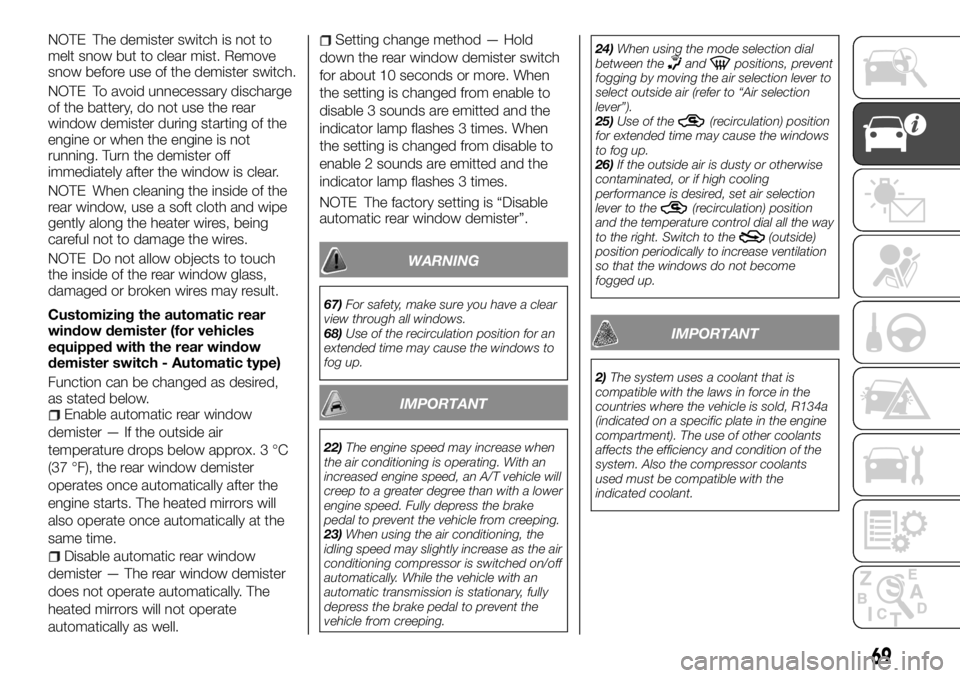
NOTE The demister switch is not to
melt snow but to clear mist. Remove
snow before use of the demister switch.
NOTE To avoid unnecessary discharge
of the battery, do not use the rear
window demister during starting of the
engine or when the engine is not
running. Turn the demister off
immediately after the window is clear.
NOTE When cleaning the inside of the
rear window, use a soft cloth and wipe
gently along the heater wires, being
careful not to damage the wires.
NOTE Do not allow objects to touch
the inside of the rear window glass,
damaged or broken wires may result.
Customizing the automatic rear
window demister (for vehicles
equipped with the rear window
demister switch - Automatic type)
Function can be changed as desired,
as stated below.
Enable automatic rear window
demister — If the outside air
temperature drops below approx. 3 °C
(37 °F), the rear window demister
operates once automatically after the
engine starts. The heated mirrors will
also operate once automatically at the
same time.
Disable automatic rear window
demister — The rear window demister
does not operate automatically. The
heated mirrors will not operate
automatically as well.
Setting change method — Hold
down the rear window demister switch
for about 10 seconds or more. When
the setting is changed from enable to
disable 3 sounds are emitted and the
indicator lamp flashes 3 times. When
the setting is changed from disable to
enable 2 sounds are emitted and the
indicator lamp flashes 3 times.
NOTE The factory setting is “Disable
automatic rear window demister”.
WARNING
67)For safety, make sure you have a clear
view through all windows.
68)Use of the recirculation position for an
extended time may cause the windows to
fog up.
IMPORTANT
22)The engine speed may increase when
the air conditioning is operating. With an
increased engine speed, an A/T vehicle will
creep to a greater degree than with a lower
engine speed. Fully depress the brake
pedal to prevent the vehicle from creeping.
23)When using the air conditioning, the
idling speed may slightly increase as the air
conditioning compressor is switched on/off
automatically. While the vehicle with an
automatic transmission is stationary, fully
depress the brake pedal to prevent the
vehicle from creeping.24)When using the mode selection dial
between the
andpositions, prevent
fogging by moving the air selection lever to
select outside air (refer to “Air selection
lever”).
25)Use of the
(recirculation) position
for extended time may cause the windows
to fog up.
26)If the outside air is dusty or otherwise
contaminated, or if high cooling
performance is desired, set air selection
lever to the
(recirculation) position
and the temperature control dial all the way
to the right. Switch to the
(outside)
position periodically to increase ventilation
so that the windows do not become
fogged up.
IMPORTANT
2)The system uses a coolant that is
compatible with the laws in force in the
countries where the vehicle is sold, R134a
(indicated on a specific plate in the engine
compartment). The use of other coolants
affects the efficiency and condition of the
system. Also the compressor coolants
used must be compatible with the
indicated coolant.
69
Page 72 of 312
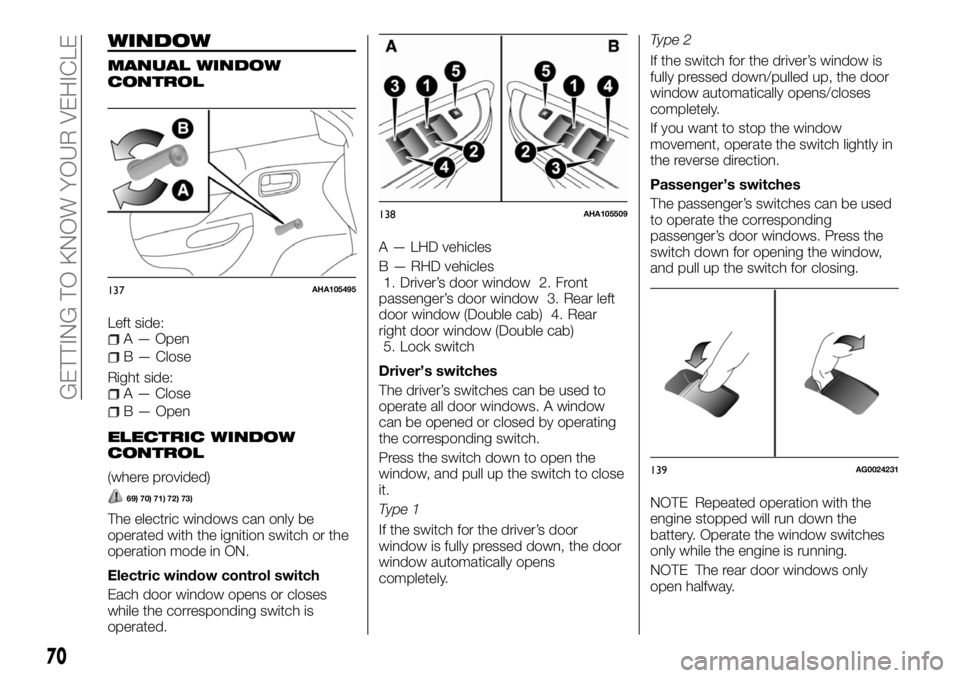
WINDOW
MANUAL WINDOW
CONTROL
Left side:A — Open
B — Close
Right side:
A — Close
B — Open
ELECTRIC WINDOW
CONTROL
(where provided)
69) 70) 71) 72) 73)
The electric windows can only be
operated with the ignition switch or the
operation mode in ON.
Electric window control switch
Each door window opens or closes
while the corresponding switch is
operated.A — LHD vehicles
B — RHD vehicles
1. Driver’s door window 2. Front
passenger’s door window 3. Rear left
door window (Double cab) 4. Rear
right door window (Double cab)
5. Lock switch
Driver’s switches
The driver’s switches can be used to
operate all door windows. A window
can be opened or closed by operating
the corresponding switch.
Press the switch down to open the
window, and pull up the switch to close
it.
Type 1
If the switch for the driver’s door
window is fully pressed down, the door
window automatically opens
completely.Type 2
If the switch for the driver’s window is
fully pressed down/pulled up, the door
window automatically opens/closes
completely.
If you want to stop the window
movement, operate the switch lightly in
the reverse direction.
Passenger’s switches
The passenger’s switches can be used
to operate the corresponding
passenger’s door windows. Press the
switch down for opening the window,
and pull up the switch for closing.
NOTE Repeated operation with the
engine stopped will run down the
battery. Operate the window switches
only while the engine is running.
NOTE The rear door windows only
open halfway.
137AHA105495
138AHA105509
139AG0024231
70
GETTING TO KNOW YOUR VEHICLE
Page 73 of 312
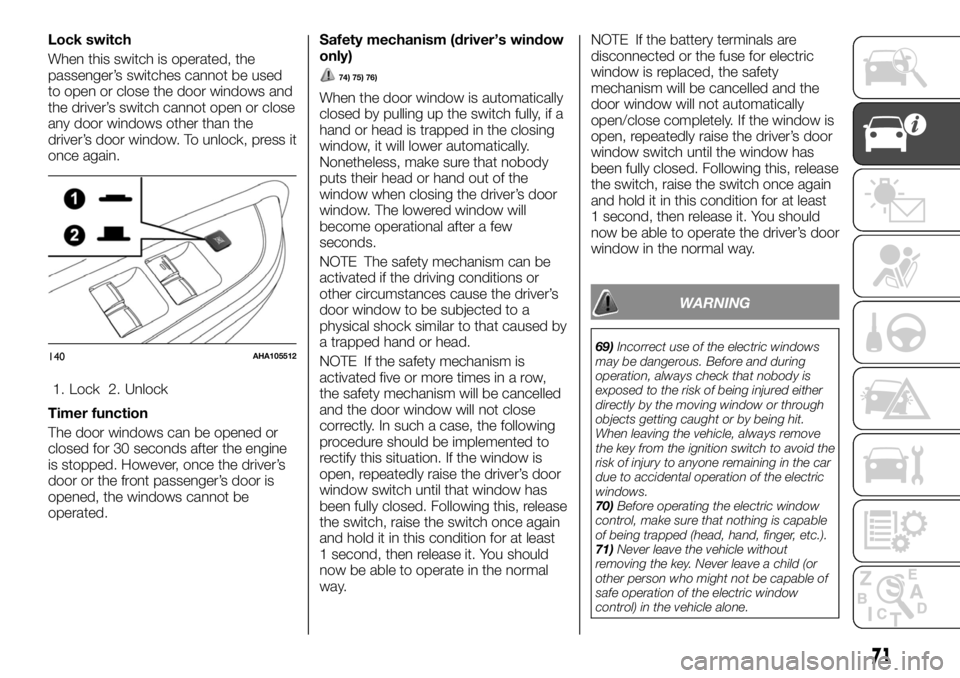
Lock switch
When this switch is operated, the
passenger’s switches cannot be used
to open or close the door windows and
the driver’s switch cannot open or close
any door windows other than the
driver’s door window. To unlock, press it
once again.
1. Lock 2. Unlock
Timer function
The door windows can be opened or
closed for 30 seconds after the engine
is stopped. However, once the driver’s
door or the front passenger’s door is
opened, the windows cannot be
operated.Safety mechanism (driver’s window
only)
74) 75) 76)
When the door window is automatically
closed by pulling up the switch fully, if a
hand or head is trapped in the closing
window, it will lower automatically.
Nonetheless, make sure that nobody
puts their head or hand out of the
window when closing the driver’s door
window. The lowered window will
become operational after a few
seconds.
NOTE The safety mechanism can be
activated if the driving conditions or
other circumstances cause the driver’s
door window to be subjected to a
physical shock similar to that caused by
a trapped hand or head.
NOTE If the safety mechanism is
activated five or more times in a row,
the safety mechanism will be cancelled
and the door window will not close
correctly. In such a case, the following
procedure should be implemented to
rectify this situation. If the window is
open, repeatedly raise the driver’s door
window switch until that window has
been fully closed. Following this, release
the switch, raise the switch once again
and hold it in this condition for at least
1 second, then release it. You should
now be able to operate in the normal
way.NOTE If the battery terminals are
disconnected or the fuse for electric
window is replaced, the safety
mechanism will be cancelled and the
door window will not automatically
open/close completely. If the window is
open, repeatedly raise the driver’s door
window switch until the window has
been fully closed. Following this, release
the switch, raise the switch once again
and hold it in this condition for at least
1 second, then release it. You should
now be able to operate the driver’s door
window in the normal way.
WARNING
69)Incorrect use of the electric windows
may be dangerous. Before and during
operation, always check that nobody is
exposed to the risk of being injured either
directly by the moving window or through
objects getting caught or by being hit.
When leaving the vehicle, always remove
the key from the ignition switch to avoid the
risk of injury to anyone remaining in the car
due to accidental operation of the electric
windows.
70)Before operating the electric window
control, make sure that nothing is capable
of being trapped (head, hand, finger, etc.).
71)Never leave the vehicle without
removing the key. Never leave a child (or
other person who might not be capable of
safe operation of the electric window
control) in the vehicle alone.140AHA105512
71
Page 74 of 312
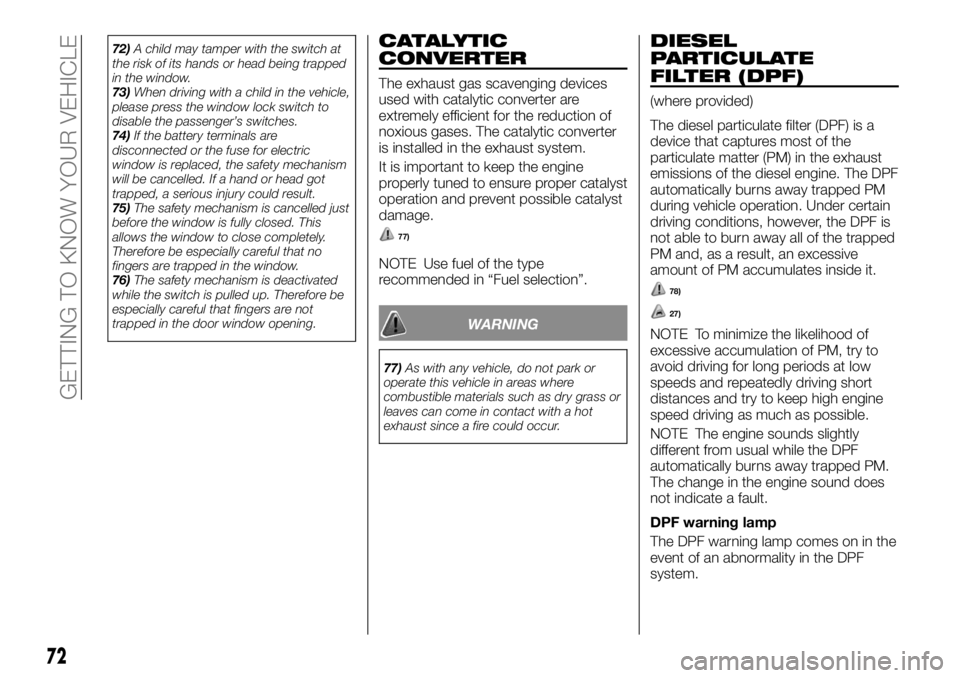
72)A child may tamper with the switch at
the risk of its hands or head being trapped
in the window.
73)When driving with a child in the vehicle,
please press the window lock switch to
disable the passenger’s switches.
74)If the battery terminals are
disconnected or the fuse for electric
window is replaced, the safety mechanism
will be cancelled. If a hand or head got
trapped, a serious injury could result.
75)The safety mechanism is cancelled just
before the window is fully closed. This
allows the window to close completely.
Therefore be especially careful that no
fingers are trapped in the window.
76)The safety mechanism is deactivated
while the switch is pulled up. Therefore be
especially careful that fingers are not
trapped in the door window opening.CATALYTIC
CONVERTER
The exhaust gas scavenging devices
used with catalytic converter are
extremely efficient for the reduction of
noxious gases. The catalytic converter
is installed in the exhaust system.
It is important to keep the engine
properly tuned to ensure proper catalyst
operation and prevent possible catalyst
damage.
77)
NOTE Use fuel of the type
recommended in “Fuel selection”.
WARNING
77)As with any vehicle, do not park or
operate this vehicle in areas where
combustible materials such as dry grass or
leaves can come in contact with a hot
exhaust since a fire could occur.
DIESEL
PARTICULATE
FILTER (DPF)
(where provided)
The diesel particulate filter (DPF) is a
device that captures most of the
particulate matter (PM) in the exhaust
emissions of the diesel engine. The DPF
automatically burns away trapped PM
during vehicle operation. Under certain
driving conditions, however, the DPF is
not able to burn away all of the trapped
PM and, as a result, an excessive
amount of PM accumulates inside it.
78)
27)
NOTE To minimize the likelihood of
excessive accumulation of PM, try to
avoid driving for long periods at low
speeds and repeatedly driving short
distances and try to keep high engine
speed driving as much as possible.
NOTE The engine sounds slightly
different from usual while the DPF
automatically burns away trapped PM.
The change in the engine sound does
not indicate a fault.
DPF warning lamp
The DPF warning lamp comes on in the
event of an abnormality in the DPF
system.
72
GETTING TO KNOW YOUR VEHICLE
Page 75 of 312
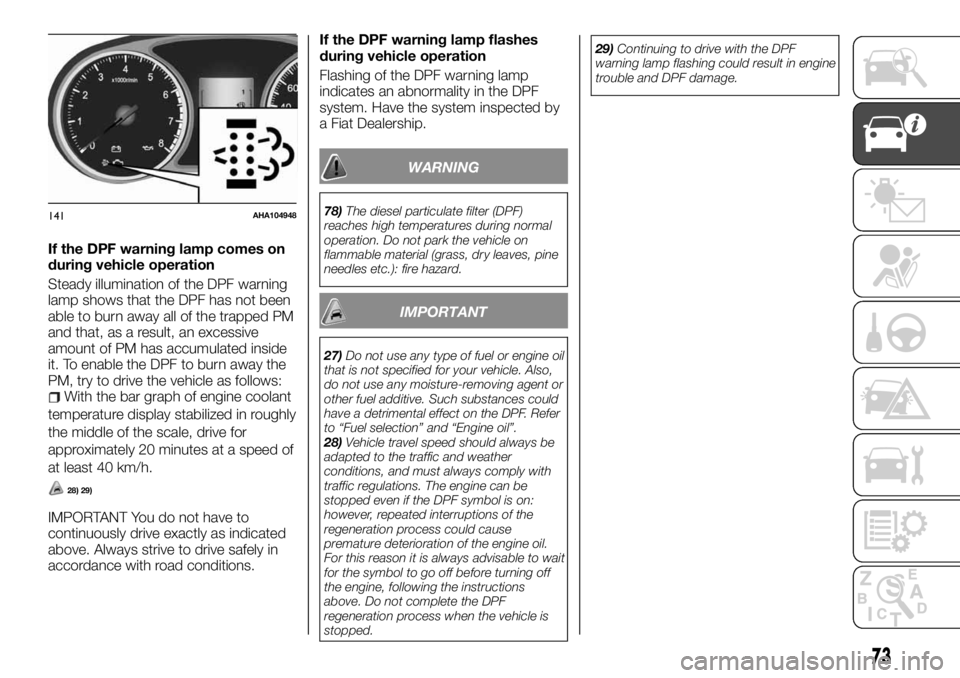
If the DPF warning lamp comes on
during vehicle operation
Steady illumination of the DPF warning
lamp shows that the DPF has not been
able to burn away all of the trapped PM
and that, as a result, an excessive
amount of PM has accumulated inside
it. To enable the DPF to burn away the
PM, try to drive the vehicle as follows:
With the bar graph of engine coolant
temperature display stabilized in roughly
the middle of the scale, drive for
approximately 20 minutes at a speed of
at least 40 km/h.
28) 29)
IMPORTANT You do not have to
continuously drive exactly as indicated
above. Always strive to drive safely in
accordance with road conditions.If the DPF warning lamp flashes
during vehicle operation
Flashing of the DPF warning lamp
indicates an abnormality in the DPF
system. Have the system inspected by
a Fiat Dealership.
WARNING
78)The diesel particulate filter (DPF)
reaches high temperatures during normal
operation. Do not park the vehicle on
flammable material (grass, dry leaves, pine
needles etc.): fire hazard.
IMPORTANT
27)Do not use any type of fuel or engine oil
that is not specified for your vehicle. Also,
do not use any moisture-removing agent or
other fuel additive. Such substances could
have a detrimental effect on the DPF. Refer
to “Fuel selection” and “Engine oil”.
28)Vehicle travel speed should always be
adapted to the traffic and weather
conditions, and must always comply with
traffic regulations. The engine can be
stopped even if the DPF symbol is on:
however, repeated interruptions of the
regeneration process could cause
premature deterioration of the engine oil.
For this reason it is always advisable to wait
for the symbol to go off before turning off
the engine, following the instructions
above. Do not complete the DPF
regeneration process when the vehicle is
stopped.29)Continuing to drive with the DPF
warning lamp flashing could result in engine
trouble and DPF damage.
141AHA104948
73
Page 76 of 312
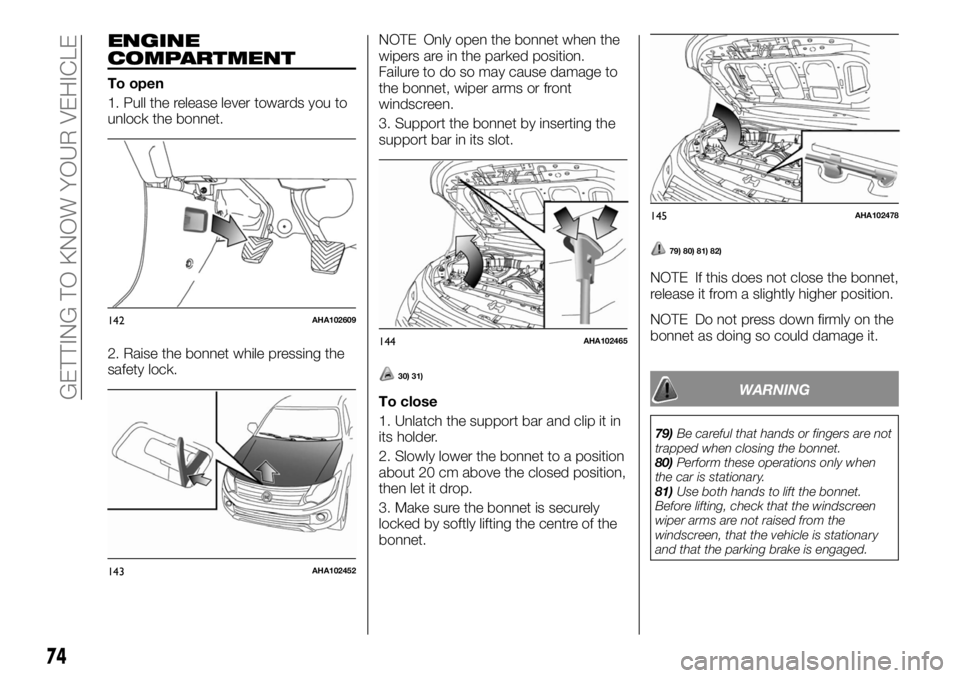
ENGINE
COMPARTMENT
To open
1. Pull the release lever towards you to
unlock the bonnet.
2. Raise the bonnet while pressing the
safety lock.NOTE Only open the bonnet when the
wipers are in the parked position.
Failure to do so may cause damage to
the bonnet, wiper arms or front
windscreen.
3. Support the bonnet by inserting the
support bar in its slot.
30) 31)
To close
1. Unlatch the support bar and clip it in
its holder.
2. Slowly lower the bonnet to a position
about 20 cm above the closed position,
then let it drop.
3. Make sure the bonnet is securely
locked by softly lifting the centre of the
bonnet.
79) 80) 81) 82)
NOTE If this does not close the bonnet,
release it from a slightly higher position.
NOTE Do not press down firmly on the
bonnet as doing so could damage it.
WARNING
79)Be careful that hands or fingers are not
trapped when closing the bonnet.
80)Perform these operations only when
the car is stationary.
81)Use both hands to lift the bonnet.
Before lifting, check that the windscreen
wiper arms are not raised from the
windscreen, that the vehicle is stationary
and that the parking brake is engaged.
142AHA102609
143AHA102452
144AHA102465
145AHA102478
74
GETTING TO KNOW YOUR VEHICLE
Page 77 of 312
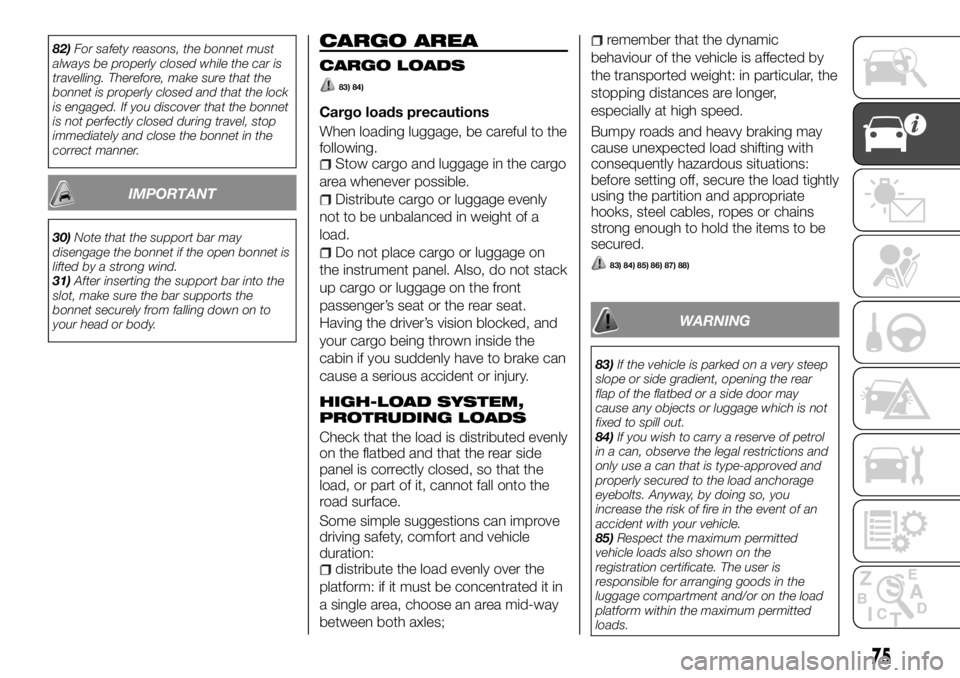
82)For safety reasons, the bonnet must
always be properly closed while the car is
travelling. Therefore, make sure that the
bonnet is properly closed and that the lock
is engaged. If you discover that the bonnet
is not perfectly closed during travel, stop
immediately and close the bonnet in the
correct manner.
IMPORTANT
30)Note that the support bar may
disengage the bonnet if the open bonnet is
lifted by a strong wind.
31)After inserting the support bar into the
slot, make sure the bar supports the
bonnet securely from falling down on to
your head or body.
CARGO AREA
CARGO LOADS
83) 84)
Cargo loads precautions
When loading luggage, be careful to the
following.
Stow cargo and luggage in the cargo
area whenever possible.
Distribute cargo or luggage evenly
not to be unbalanced in weight of a
load.
Do not place cargo or luggage on
the instrument panel. Also, do not stack
up cargo or luggage on the front
passenger’s seat or the rear seat.
Having the driver’s vision blocked, and
your cargo being thrown inside the
cabin if you suddenly have to brake can
cause a serious accident or injury.
HIGH-LOAD SYSTEM,
PROTRUDING LOADS
Check that the load is distributed evenly
on the flatbed and that the rear side
panel is correctly closed, so that the
load, or part of it, cannot fall onto the
road surface.
Some simple suggestions can improve
driving safety, comfort and vehicle
duration:
distribute the load evenly over the
platform: if it must be concentrated it in
a single area, choose an area mid-way
between both axles;
remember that the dynamic
behaviour of the vehicle is affected by
the transported weight: in particular, the
stopping distances are longer,
especially at high speed.
Bumpy roads and heavy braking may
cause unexpected load shifting with
consequently hazardous situations:
before setting off, secure the load tightly
using the partition and appropriate
hooks, steel cables, ropes or chains
strong enough to hold the items to be
secured.
83) 84) 85) 86) 87) 88)
WARNING
83)If the vehicle is parked on a very steep
slope or side gradient, opening the rear
flap of the flatbed or a side door may
cause any objects or luggage which is not
fixed to spill out.
84)If you wish to carry a reserve of petrol
in a can, observe the legal restrictions and
only use a can that is type-approved and
properly secured to the load anchorage
eyebolts. Anyway, by doing so, you
increase the risk of fire in the event of an
accident with your vehicle.
85)Respect the maximum permitted
vehicle loads also shown on the
registration certificate. The user is
responsible for arranging goods in the
luggage compartment and/or on the load
platform within the maximum permitted
loads.
75
Page 78 of 312
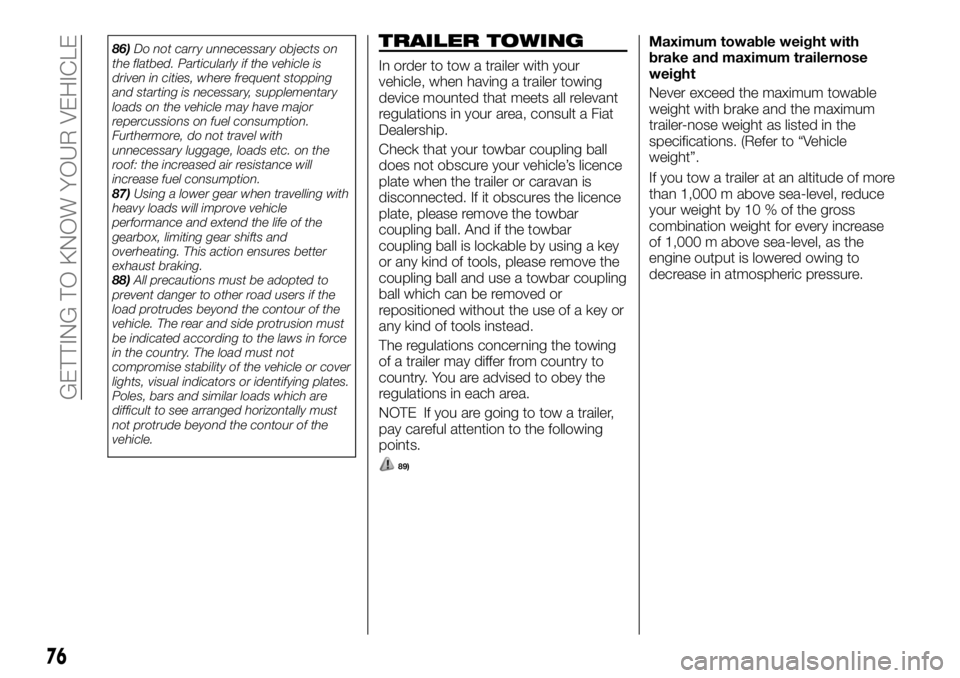
86)Do not carry unnecessary objects on
the flatbed. Particularly if the vehicle is
driven in cities, where frequent stopping
and starting is necessary, supplementary
loads on the vehicle may have major
repercussions on fuel consumption.
Furthermore, do not travel with
unnecessary luggage, loads etc. on the
roof: the increased air resistance will
increase fuel consumption.
87)Using a lower gear when travelling with
heavy loads will improve vehicle
performance and extend the life of the
gearbox, limiting gear shifts and
overheating. This action ensures better
exhaust braking.
88)All precautions must be adopted to
prevent danger to other road users if the
load protrudes beyond the contour of the
vehicle. The rear and side protrusion must
be indicated according to the laws in force
in the country. The load must not
compromise stability of the vehicle or cover
lights, visual indicators or identifying plates.
Poles, bars and similar loads which are
difficult to see arranged horizontally must
not protrude beyond the contour of the
vehicle.TRAILER TOWING
In order to tow a trailer with your
vehicle, when having a trailer towing
device mounted that meets all relevant
regulations in your area, consult a Fiat
Dealership.
Check that your towbar coupling ball
does not obscure your vehicle’s licence
plate when the trailer or caravan is
disconnected. If it obscures the licence
plate, please remove the towbar
coupling ball. And if the towbar
coupling ball is lockable by using a key
or any kind of tools, please remove the
coupling ball and use a towbar coupling
ball which can be removed or
repositioned without the use of a key or
any kind of tools instead.
The regulations concerning the towing
of a trailer may differ from country to
country. You are advised to obey the
regulations in each area.
NOTE If you are going to tow a trailer,
pay careful attention to the following
points.
89)
Maximum towable weight with
brake and maximum trailernose
weight
Never exceed the maximum towable
weight with brake and the maximum
trailer-nose weight as listed in the
specifications. (Refer to “Vehicle
weight”.
If you tow a trailer at an altitude of more
than 1,000 m above sea-level, reduce
your weight by 10 % of the gross
combination weight for every increase
of 1,000 m above sea-level, as the
engine output is lowered owing to
decrease in atmospheric pressure.
76
GETTING TO KNOW YOUR VEHICLE
Page 79 of 312
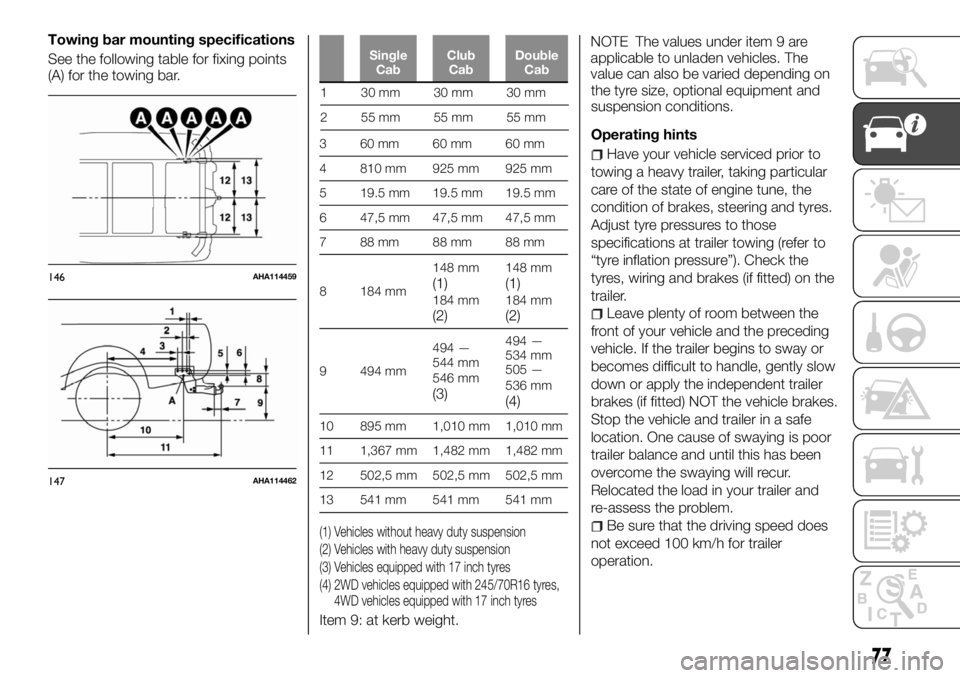
Towing bar mounting specifications
See the following table for fixing points
(A) for the towing bar.
1 30mm 30mm 30mm
2 55mm 55mm 55mm
Single
CabClub
CabDouble
Cab
3 60mm 60mm 60mm
4 810 mm 925 mm 925 mm
5 19.5 mm 19.5 mm 19.5 mm
6 47,5 mm 47,5 mm 47,5 mm
7 88mm 88mm 88mm
8 184 mm148 mm
(1)184 mm(2)
148 mm(1)184 mm(2)
9 494 mm494 —
544 mm
546 mm
(3)
494 —
534 mm
505 —
536 mm
(4)
10 895 mm 1,010 mm 1,010 mm
11 1,367 mm 1,482 mm 1,482 mm
12 502,5 mm 502,5 mm 502,5 mm
13 541 mm 541 mm 541 mm
(1) Vehicles without heavy duty suspension
(2) Vehicles with heavy duty suspension
(3) Vehicles equipped with 17 inch tyres
(4) 2WD vehicles equipped with 245/70R16 tyres,
4WD vehicles equipped with 17 inch tyres
Item 9: at kerb weight.NOTE The values under item 9 are
applicable to unladen vehicles. The
value can also be varied depending on
the tyre size, optional equipment and
suspension conditions.
Operating hints
Have your vehicle serviced prior to
towing a heavy trailer, taking particular
care of the state of engine tune, the
condition of brakes, steering and tyres.
Adjust tyre pressures to those
specifications at trailer towing (refer to
“tyre inflation pressure”). Check the
tyres, wiring and brakes (if fitted) on the
trailer.
Leave plenty of room between the
front of your vehicle and the preceding
vehicle. If the trailer begins to sway or
becomes difficult to handle, gently slow
down or apply the independent trailer
brakes (if fitted) NOT the vehicle brakes.
Stop the vehicle and trailer in a safe
location. One cause of swaying is poor
trailer balance and until this has been
overcome the swaying will recur.
Relocated the load in your trailer and
re-assess the problem.
Be sure that the driving speed does
not exceed 100 km/h for trailer
operation.
146AHA114459
147AHA114462
77
Page 80 of 312
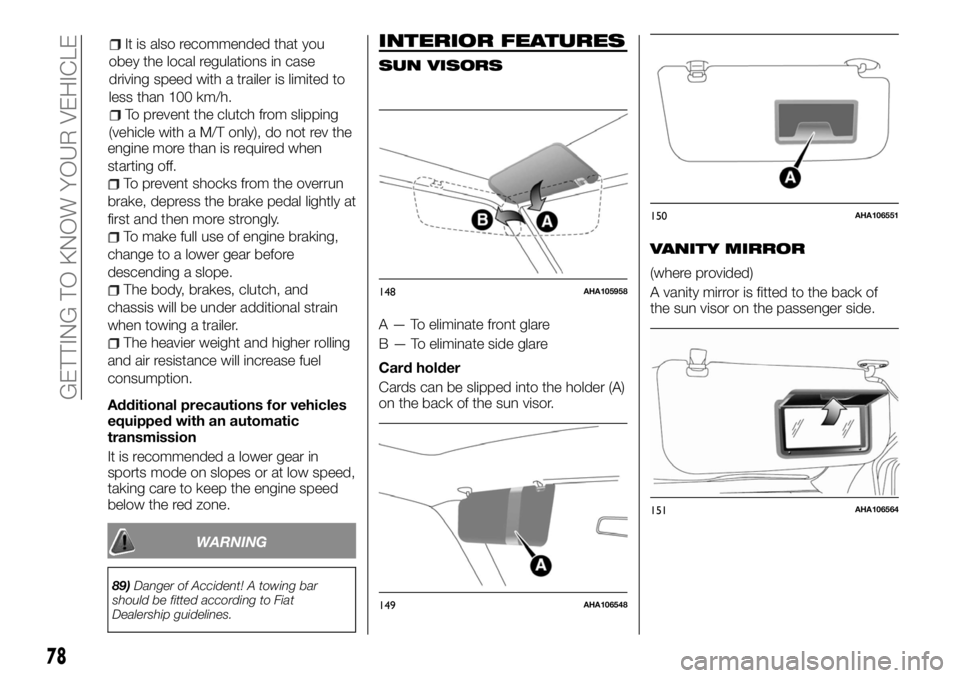
engine more than is required when
starting off.
To prevent shocks from the overrun
brake, depress the brake pedal lightly at
first and then more strongly.
To make full use of engine braking,
change to a lower gear before
descending a slope.
The body, brakes, clutch, and
chassis will be under additional strain
when towing a trailer.
The heavier weight and higher rolling
and air resistance will increase fuel
consumption.
Additional precautions for vehicles
equipped with an automatic
transmission
It is recommended a lower gear in
sports mode on slopes or at low speed,
taking care to keep the engine speed
below the red zone.
WARNING
89)Danger of Accident! A towing bar
should be fitted according to Fiat
Dealership guidelines.
INTERIOR FEATURES
SUN VISORS
A — To eliminate front glare
B — To eliminate side glare
Card holder
Cards can be slipped into the holder (A)
on the back of the sun visor.
VANITY MIRROR
(where provided)
A vanity mirror is fitted to the back of
the sun visor on the passenger side.
148AHA105958
149AHA106548
150AHA106551
151AHA106564
78
GETTING TO KNOW YOUR VEHICLE
It is also recommended that you
obey the local regulations in case
driving speed with a trailer is limited to
less than 100 km/h.
To prevent the clutch from slipping
(vehicle with a M/T only), do not rev the